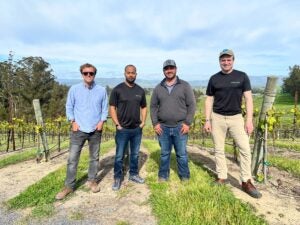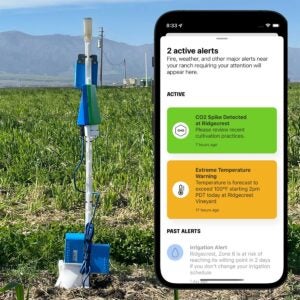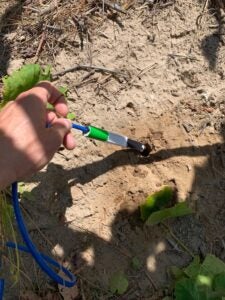If there was just one phrase that good farmers love to say, it would be “you can’t manage what you can’t measure.” A simple concept, but quite obviously true.
Agrology is a company founded on the principle that “better outcomes start with accurate measurement,” and it is making strides in technology that not only measures greenhouse gasses (GHG) coming from the soil, but also uses real time data to determine upcoming weather events in fields.
Agrology was started in 2019 by partners Adam Koeppel, Tyler Locke, and Kevin Kelly. Maybe you haven’t heard of Agrology yet, but this won’t be the last time you’ll hear about them.
The trio set out to create technology to help farmers measure their impact on the environment and better deal with the extreme weather events that have become all too common.
So what does that kind of tech actually look like and what does it offer farmers? Simply put, Agrology makes probes and gas monitoring chambers for in-field use. A farmer places multiple units in a field strategically to gather representative data. These units send real-time data to an app on your phone and a grower dashboard on the computer.

Together the team has launched two in-field monitoring systems and one database platform, with a third in-field monitoring system on its way.
The first monitoring system it created is called Sentinel, which helps growers with challenges such as crops being tainted with wildfire smoke, drought and irrigation optimization, pest and disease prevention, and monitoring for extreme events within the microclimates of the particular field.
Riggs Lokka, owner of Emeritus Vineyards in Sebastopol, California, was an early adopter of the Sentinel technology. He tells a story about the time there was a wildfire 10 miles from the vineyard. Because smoke heavily taints the flavor of grapes, his team harvested throughout the night to avoid the possibility of smoke ruining their harvest.
Agrology says Sentinel continuously monitors the chemical composition of the air throughout a farm to detect the presence of damaging wildfire smoke. The data platforms then can send alerts to farmers.
Agrology’s chief of staff, Holly Nuss, says that in addition to alerts on their phone, “Farmers can receive four-day precision predictions on the Agrology app on smartphones or desktops about extreme weather events.”
Monitoring systems for all aspects of farming are coming out seemingly every day, many farmers have more than 10 platforms to watch daily, so adding another isn’t always attractive to farmers, especially since they aren’t all easy to use. Nuss emphasized that Agrology’s platform is easy to use and read. She says that one of the founders tells people that “data itself isn’t useful; we need to process the data with machine learning into predictive warnings and insights that farmers can use.”

The second monitoring system Agrology offers is called Arbiter, which monitors carbon sequestration and emissions, future weather events, and soil conditions. Arbiter is gaining momentum as one of the few affordable ways to measure real-time carbon and greenhouse gas footprints in the field.
Contrary to some mainstream misconceptions, research into soil health, soil carbon sequestration and soil GHG emission has been happening for years in agriculture — the problem is that it is often unaffordable and not sustainable for in-field use. Agrology hopes its Arbiter system reduces those barriers.
Arbiter can measure these data points in the field and can help farms experiment with what works best for them to keep emissions down and carbon sequestration up. Arbiter has a probe that goes into the soil to monitor soil temperature and moisture levels. Growers know that we can influence the moisture levels in soil with different cultivation techniques, and Arbiter allows farmers to truly measure the impact on the soil.

Arbiter uses a database of existing weather monitoring systems — along with the soil monitoring probes — to accurately predict weather on what they call a “nanoclimate” scale. What does that mean exactly?
It means that Arbiter is able to predict the weather in different areas of the field, and it will send farmers alerts if an extreme weather event is going to happen in any part of the field.
Nuss and Koeppel said that a vineyard that utilizes Arbiter thought the same thing. They received their first extreme weather alert stating that during a heat dome, one block of their vineyard would reach 120 degrees in three days. 120 degrees in the beating sun would surely ruin the grapes. It was hard to believe. Why would it only get to 120 degrees in that one block of the vineyard? The farmer didn’t shift their harvesting teams based on the Arbiter’s alert, and in three days, he lost those grapes to the heat dome.
You wouldn’t be alone in thinking that this sounds too good to be true. Nuss and Koeppel said that a vineyard that utilizes Arbiter thought the same thing — but then it received its first extreme weather alert stating that one particular block of their vineyard was in a heat dome and would reach 120 degrees in three days. It’s certain that 120 degrees in the beating sun would ruin the grapes, yet it was hard to believe, because why would it get to 120 degrees only in that one particular block of the vineyard? The farmer didn’t shift their harvesting teams based on the Arbiter’s alert, and in three days, he lost those grapes due to the heat dome.
Arbiter has many attractive features that Koeppel says allows farmers to run in-house trials on what works best for them.
Braga Fresh, a conventional and organic produce farm in California, uses Arbiter to help decide what practices are best for their farm with the overall goal of sustainability in mind. Check out Braga Fresh’s video on how they use Arbiter in their fields:
Agrology beta tested the first commercial nitrous oxide (N2O) flux monitoring system in 2023. The company debuted it to multiple customers in 2024 and will offer wide availability for the N2O monitoring system by 2025. Being able to affordably measure N2O is a big deal because it has a much graver effect on the environment than carbon dioxide — about 300 times the impact, in fact. Although N2O doesn’t make up a large percentage of the GHG affecting the climate, it’s a very potent gas. According to the U.S. Environmental Protection Agency, agricultural soil management is the main culprit for N2O in the atmosphere.
A 2022 study on N2O mitigation strategies in agriculture offers this perspective of N2O in agriculture: “The amount of N2O produced from the soil through the combined processes of nitrification and denitrification is profoundly influenced by temperature, moisture, carbon, nitrogen and oxygen contents. These factors can be manipulated to a significant extent through field management practices, influencing N2O emission.”
Profoundly influenced by … temperature (check!), moisture (check!), carbon (check!), nitrogen and oxygen (check and check!). Agrology has created technology to monitor all of these things, and soon farmers will be able to manipulate their field work techniques to decrease N2O emissions.
Koeppel said in an interview that the question from the beginning of this journey was, “How do we take technology known to measure emissions and make it affordable?”
Agrology is built on the foundation of allowing farmers to “build their biggest asset — soil!,” according to Nuss.
This groundbreaking technology comes with a cost, of course, but Agrology is subscription-based. If you purchase the Sentinel or Arbiter products today, you won’t be left out of future updates. Additionally, Koeppel notes that the company’s technology isn’t a sunk cost; he affirms that farmers are finding ways to save money by utilizing this technology, whether that’s through acting on extreme weather events, investing in the most affordable ways to build soil health, or swapping expensive crop protection products with new cultivation techniques.
Looking forward, Koeppel is excited about the N2O technology hitting the ground, and Agrology is working every day to make this technology more efficient and diverse. There’s also been a huge uptick in popularity of “climate smart” commodities, which Agrology’s technology is allowing more farmers to play a role in.
Koeppel adds that “there’s an unfortunate standard that farmers aren’t good stewards” of the land, which is not true at all! He says that they work with all farmers from high end wine, all the way to cotton and rangeland. Because Agrology’s monitoring systems are so mobile, it’s easy for farmers to install the technology themselves if they need to move them around.
Agrology can be found on YouTube, LinkedIn, and Instagram. There is also this whitepaper on Arbiter.
Elizabeth Maslyn is a born-and-raised dairy farmer from Upstate New York. Her passion for agriculture has driven her to share the stories of farmers with all consumers, and promote agriculture in everything she does. She works hard to increase food literacy in her community, and wants to share the stories of her local farmers.



